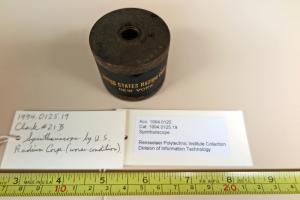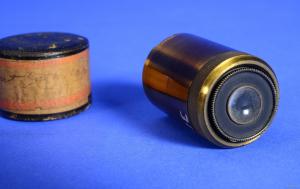![Pierre Curie (1859-1906) and Marie Sklodowska Curie (1867-1934), c. 1903, 1903, Smithsonian Institution Archives, SIA Acc. 90-105 [SIA2008-0751]. Pierre Curie (1859-1906) and Marie Sklodowska Curie (1867-1934), c. 1903](https://ids.si.edu/ids/iiif/SIA-SIA2008-0751/full/250,/0/default.jpg)
Radium was discovered by Marie Curie and her husband Pierre in late 1898, and took the scientific world by storm. When George Barker gave a lecture on “the New Element” in New York in early 1900, displaying a tiny bit of radium that had come from Paris, news reports proclaimed: “The Most Important Discovery of the Century.” William Crookes, the prominent but somewhat controversial London chemist who had discovered thallium many years earlier, jumped on the discovery and, along with his assistant, set out to separate some radium from the uranium in pitchblende.
In early 1903—after the Curies announced that radium possesses the “extraordinary property of continuously emitting heat, without combustion, without chemical change of any kind, and without any change in its molecular structure”—London newspapers turned to Crookes for comments. His interest in the matter thus renewed, Crookes noticed that when he placed a screen coated with a material such as zinc sulphide near an alpha-active substance, a brilliant luminosity appeared, and a pocket lens revealed a large number of scintillating points on the screen. This, in essence, was the spinthariscope. Crookes took an example to the Royal Society Conversazione on May 15, an annual event where scientists shared their work with nobs. It was the highlight of the evening. Chemical News, a weekly publication controlled by Crookes, discussed the spinthariscope soon thereafter. The Illustrated London News quoted Crookes saying that the most striking way of showing the emanations of radium “is by the little contrivance I call a Spinthariscope.” The term derived from the Greek word for scintillation.
Early June found Crookes at the International Congress for Applied Chemistry in Berlin, discussing radium and displaying spinthariscopes. Late June found him in London, chairing the large Royal Institution meeting at which Pierre Curie lectured on radium. September found him at the annual meeting of the British Association for the Advancement of Science. There, the president of the Section on the Mathematical and Physical Sciences said that the properties of radium “transcended all others in their intrinsic importance and revolutionary possibilities.” Crookes, he went on to say, had devised “an experiment in which a particle of radium kept a screen bombarded forever, each collision producing a microscopic flash of light, the dancing and multitude of which forcibly compelled the imagination to follow the reasoning faculties and realize the existence of atomic tumult.”

Crookes’ primary American correspondent at the time was Samuel Pierpont Langley, an astrophysicist then serving as the Secretary of the Smithsonian. As his predecessors had done, Langley used the appendices to the Institution’s Annual Reports to inform Americans about European science. Reprints of two of Crookes’ articles appeared in the volume for 1899 (which appeared in 1901). One was his lecture on diamonds prepared at the time of Queen Victoria’s Diamond Jubilee. The other was an account of psychical research. In his preface to the latter, Langley noted that the Institution preferred scientific facts to speculations, but Crookes’ speculations are “so weighty and ingeniously illustrated that an exception is here made in their favor, but it is to be repeated that they are not presented as demonstrated fact.”
That same volume carried “An Experimental Study of Radio-Active Substances” written by Henry Carrington Bolton, a chemist affiliated with the Smithsonian. Bolton was able to do this work because Crookes had sent Langley information about where to shop for radioactive materials prepared according to the instructions of Madame and Monsieur Curie.
The Smithsonian bought a spinthariscope in 1903, and received another from Crookes in 1913. A spinthariscope now in the National Museum of American History is probably one of those instruments.

In 1916, the Smithsonian hosted a temporary exhibit of safety measures undertaken and promoted by agencies the federal government. Here, the Bureau of Mines displayed two spinthariscopes, two radium safety signs, and a small tube containing radium chloride.
In 1921, Marie Curie visited Washington and received a gram of radium purchased with funds raised by American women. In honor of this occasion, the Smithsonian invited Robert Milliken, professor of physics at the University of Chicago, to lecture on radium. And the Smithsonian’s Department of Geology organized an exhibit of radium ores, radioactive minerals, and radiographs. One of the Smithsonian’s spinthariscopes may have been there as well.
Related Resources
- Background on Spinthariscopes, Skulls in the Stars
Produced by the Smithsonian Institution Archives. For copyright questions, please see the Terms of Use.

Leave a Comment